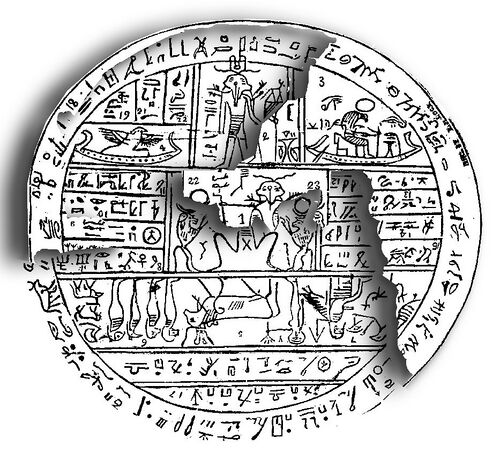
FAIR is a non-profit organization dedicated to providing well-documented answers to criticisms of the doctrine, practice, and history of The Church of Jesus Christ of Latter-day Saints.
The illustration represented by Facsimile 2 (view) is a hypocephalus, a disc made of linen, papyrus, or bronze, covered with inscriptions and images which relate to one of the last spells in the Book of the Dead. The disc was placed under the head (hypocephalus = Greek: "under the head") of the deceased in the belief that the spell would cause the head and body to be enveloped in flames or radiance, making the deceased divine. Joseph Smith's notes to Facsimile 2 identify several figures as representing God sitting in the heavens among the stars and others of his creations.
Criticisms related to Facsimile 2 are related to Joseph Smith's explanations of the individual elements.
Joseph Smith provided this explanation in Book of Abraham, Facsimile 2, Figure 5:
one of the governing planets also, and is said by the Egyptians to be the Sun, and to borrow its light from Kolob through the medium of Kae-e-vanrash, which is the grand Key, or, in other words, the governing power, which governs fifteen other fixed planets or stars, as also Floeese or the Moon, the Earth and the Sun in their annual revolutions.
Kolob is said to be the planet nearest to the throne of God, "which Kolob is set nigh unto the throne of God, to govern all those planets which belong to the same order as that upon which thou standest." Abraham 3꞉9. The light and power of God extend from his throne to govern all things in the universe.
7 Which truth shineth. This is the light of Christ. As also he is in the sun, and the light of the sun, and the power thereof by which it was made.
8 As also he is in the moon, and is the light of the moon, and the power thereof by which it was made;
9 As also the light of the stars, and the power thereof by which they were made;
10 And the earth also, and the power thereof, even the earth upon which you stand.
11 And the light which shineth, which giveth you light, is through him who enlighteneth your eyes, which is the same light that quickeneth your understandings;
12 Which light proceedeth forth from the presence of God to fill the immensity of space—
13 The light which is in all things, which giveth life to all things, which is the law by which all things are governed, even the power of God who sitteth upon his throne, who is in the bosom of eternity, who is in the midst of all things.



FAIR is a non-profit organization dedicated to providing well-documented answers to criticisms of the doctrine, practice, and history of The Church of Jesus Christ of Latter-day Saints.
We are a volunteer organization. We invite you to give back.
Donate Now